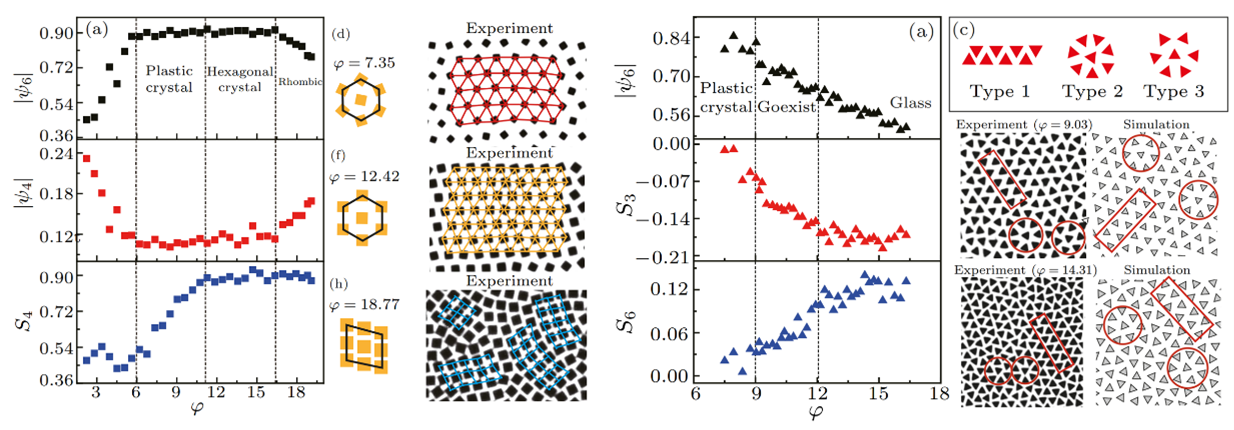Amorphous solid
Background
Amorphous materials are solids with mechanical moduli but structurally disordered like liquids. One big challenge in amorphous solids is to clarify the nature of glass and glass transition. Using colloidal or granular system, we conduct experiments to explore the vibrational modes and relaxational behaviors, which can help us to understand the structural complexity intrinsic to disordered systems and the non-equilibrium nature of a glassy state.
Finished Work
Mode properties of systems with structural disorder or dynamic disorder.(2012&2016)
Understanding the Low-Frequency Quasilocalized Modes in Disordered Colloidal Systems. (2012)
In disordered colloidal systems, we experimentally measure the normal modes with the covariance matrix method and clarify the origin of low-frequency quasilocalization at the single-particle level. We observe important features from both jamming and glass simulations: There is a plateau in the density of states [] which is suppressed upon compression, as predicted by jamming; within the same systems, we also find that the low-frequency quasilocalization originates from the large vibrations of defective structures coupled with transverse excitations, consistent with a recent glass simulation. The coexistence of these features demonstrates an experimental link between jamming and glass. Extensive simulations further show that such a structural origin of quasilocalization is universally valid for various temperatures and volume fractions.

Fig.1. Vibration distribution in real and Fourier spaces.

Fig.2. The agreement of “”, “”, “”.
More details in:
Phys. Rev. Lett. 108, 095501 (2012).
Probing the role of mobility in the collective motion of nonequilibrium systems.
We experimentally study the influence of particle mobility on system’s collective motion. Interestingly, our structurally ordered nonequilibrium system exhibits properties almost identical to disordered glassy systems under thermal equilibrium: the modes with large overall motions are spatially correlated and quasilocalized while the modes with small collective motions are highly localized, resembling the low- and high-frequency modes in glass. More surprisingly, a peak similar to the boson peak forms in our nonequilibrium system as the number of mobile particles increases, revealing the possible origin of the boson peak from a dynamic aspect. We further illustrate that the spatially correlated large movement modes can be produced by the cooperation of highly active particles above a threshold fraction, while the localized small-movement modes can be created by adding individual inactive particles. Our study clarifies the role of mobility in collective motions, and further suggests a promising possibility of extending the powerful mode analysis approach to nonequilibrium systems.

Fig.3. The D()/ spectra and distribution of time-averaged local displacement. Tuning the active
particles in sample D back to normal activities eliminates the peak.
More details in:
Phys. Rev. Lett. 116 048302 (2016)
Relaxation mechanisms of long-range interacting polygons. (2019 & 2020)
A universal state and its relaxation mechanisms of long-range interacting polygons.
Using polygonal magnetic particles, we conduct experiments to explore the coupling between long-range interaction effect and short-range shape effect. In contrast to previous studies, we obtain the surprising finding that our systems’ structures do not depend on the shape of building blocks: a single state, the hexagonal plastic crystal, appears as a universal attractor for a wide range of different polygons. This robust particle-shape independency appears as the interactions go beyond nearest neighbors. Particle shape plays an essential role in system relaxation, and determines the basic relaxation dynamics through a microscopic control parameter, internal roughness, produced by particle vertices. Thus, our study reveals a new pattern-forming paradigm, in which particle shape plays little role in the static structure but determines the essential relaxation dynamics.

Fig.1. Relaxation dynamics determined by vertex structures.
More details in:
Nat. Commun. (2019).
Coupling between Particle Shape and Long-Range Interaction in the High-Density Regime.
We study it further in the high-density regime. For two typical space-filling polygons, square and triangle, we find two types of coupling modes that predominantly control the structure formation. Specifically, the rotational ordering of squares brings a lattice deformation that produces a hexagonal-to-rhombic transition in the high-density regime, whereas the alignment of triangles introduces a large geometric frustration that causes an order-to-disorder transition. Moreover, the two coupling modes lead to small and large “internal roughness” of the two systems, and thus predominantly control their structure relaxations.

Fig.2. Structure transition in the high-density regime.
Left: Hexagonal-to-rhombic structure transition of a square-particle system.
Right: order-to-disorder transition of triangle-particle systems.
More details in:
Chinese Phys. Lett. (2020).
Relaxation modes in a glassy system. (2023)
Visualizing slow internal relaxations in a two-dimensional glassy system. (2023)
Unlike a crystal, a glassy solid state displays slow internal relaxation processes besides vibrational modes even when structural () relaxation is frozen. The precise nature of such residual local relaxation modes remains poorly understood due to the lack of real-space information. Here we directly visualize the internal relaxations in a glass via a long-time observation of the dynamics of a mechanically driven two-dimensional granular system that shows a pinning-induced transition. This allows directly visualizing the internal relaxations in a glass. On approaching the glass transition, vanishing cage-breaking motion is observed, accompanied by the emergence of a restricted dynamic mode characterizing slow relaxation. The emergence of bond rigidity freezes the structure relaxation and leads to slow motion. Our findings indicate that unlike crystallization, where all the bonds are constrained, vitrification in a disordered system freezes relaxation and accompanies elastic percolation, but the remaining non-constrained bonds provide room for slow relaxation.

Fig.1. Experimental setup (left) and Schematic of the relaxation dynamics from the PEL perspective (right).

Fig.2. Comparison of internal relaxation behaviours among amorphous systems with
soft (Type I) and hard (Type II) interactions and crystalline systems.
More details in:
Nat. Phys. (2023).